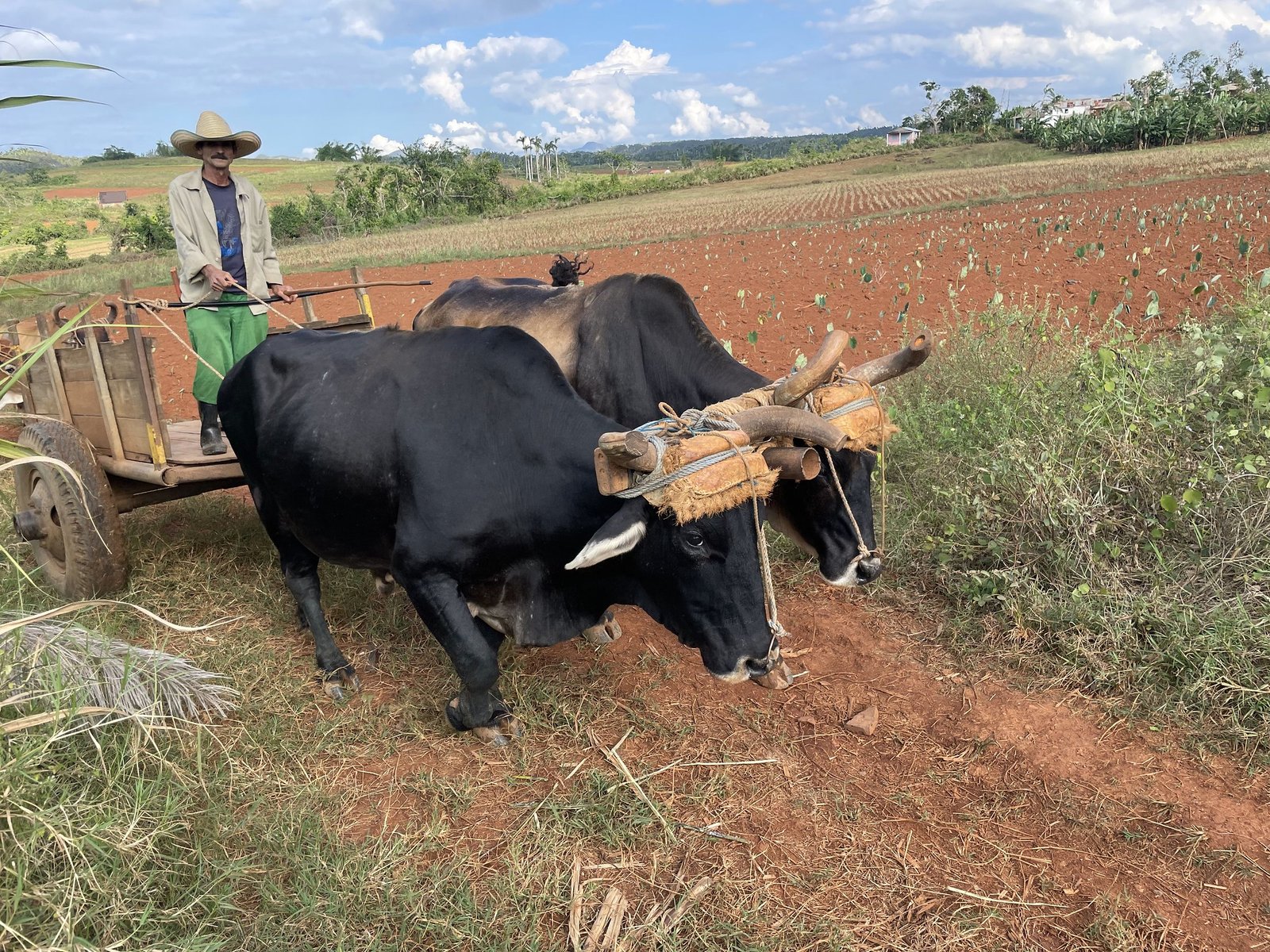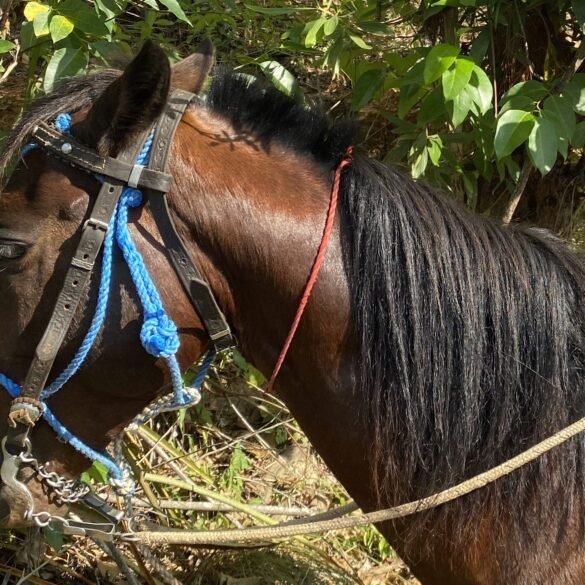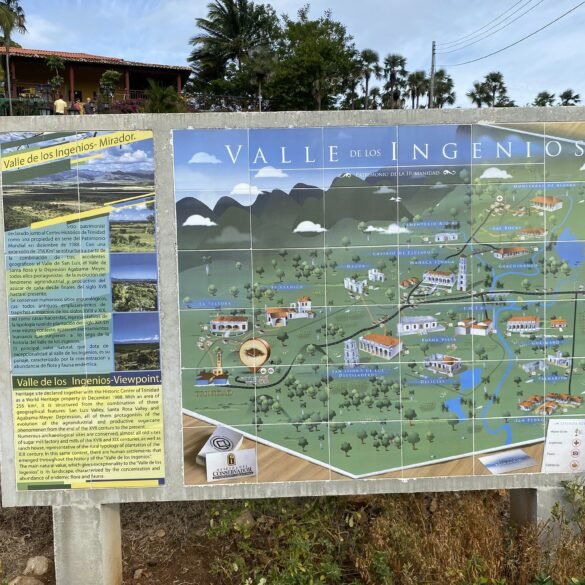In previous posts, Julia already described all the bouncing joy, painful blisters, and occasional aggressive biting of our horseback riding adventures in Viñales. While Julia’s most powerful impressions in Viñales happened on horseback, I found myself awed in the most unexpected of places – a tobacco farm.
We arrived in Viñales in the afternoon and immediately asked our Airbnb host to book us a tour around the Viñales National Park – half a day for today, and a full day for tomorrow. A half-day tour was straightforward: horseback riding, a visit to a cave with an underground lake, viewing rock paintings, and then back home. As for the second day, our guide breathlessly listed the offerings – horse carriage ride, horseback riding, tobacco farm, rum tasting, cave exploration, boat ride, oxen carriage ride, hiking up a mountain…
“Wait! We are doing all of that tomorrow?” I asked.
“Yes!” the guide exclaimed, but I didn’t really believe him. It seemed like there weren’t enough hours in the day for everything listed.


The next morning, everything started with a horse carriage ride, just as promised. We were dropped off at a farm just outside town, where we watched a pair of oxen drag a small cart full of firewood across the yard. The owner of the farm walked us through his fields and showed off tender young plants just breaking through red soil – new tobacco plants. Close by was a large barn, its walls and roof made of long poles, placed at large gaps from each other and used to dry and cure tobacco leaves after harvest. Then, on a large porch, the owner showed us how to sort and select the leaves, picking out the largest, most intact, and prettiest leaves for the outside of the cigar and the most flavorful leaves for the filler. He then meticulously rolled the leaves together, his fingers precisely grasping and spinning the tubular form, and then skillfully wrapping it into a moistened outer leaf.
We watched, entranced. Neither of us smokes, and we had no intentions of trying a tobacco product here, but the love and admiration with which the host spoke of Cuban cigars were contagious. He told us that long before Columbus sailed to these shores, the Taino natives rolled sacred tobacco leaves and smoked rudimentary cigars for their magical and healing properties. Then, the Spanish colonists opened the first Cuban cigar factories and allowed the whole world to taste the magnificence of a Cuban cigar, made by the blood, sweat, and tears of African slaves brought across the ocean and forced to work in inhumane conditions on tobacco farms. As his fingers skillfully moved over the leaves, his voice became impassioned to make an important point – the best cigar is a hand-rolled cigar. Every year, around 100 million premium cigars are handcrafted in Cuba by professional rollers called torcedores. Torcedores, despite their humble profession, have played an important part in Cuban history. For entertainment and education, many cigar factories hired professional readers to read while workers rolled cigars, anything from love novels to news articles. Back in the 1800s, readers on the tobacco floor spread political ideas, which led to tobacco workers joining Cuba’s fight for independence from Spain.


As his story ended, the guide picked up a perfectly formed, fresh cigar that he just finished rolling. He placed it inside a humidor (a wooden box for storing cigars) and pulled out another cigar, aged for a smoother, richer taste. He cut off one end and dipped it in honey.
“It will coat your throat and make the taste smoother,” the guide said and offered it to me.
The only time I smoked a cigar was years ago on a beach in Cancun, and the bitter taste with the harsh flavor of tar dried out my throat and left me feeling nauseous for the entire day. I had no plans to try a cigar in Cuba, but at this point, it felt awkward to refuse. Cautiously, I took a small puff. The taste was smooth and earthy, with a hint of sweet and tangy honey. It was robust and relaxed at the same time, slow-burning aroma lingering in the air. While I only took a few puffs and I'm unlikely to smoke another cigar again, at least now, I understand its appeal.
Before I could even put the cigar down, shots of rum were poured and distributed around the table for the guide, Julia, and me. As far as vices go, you can do far worse than the delicate aroma of a Cuban cigar and the lingering warmth of full-bodied Cuban rum.
There are multiple pictures, all of which I'm too embarrassed to post here, of me in a borrowed cowboy hat, a cigar in my mouth, a bottle of rum in my hand, posing in front of a portrait of Che Guevara and the Cuban flag. It’s exactly as bad as it sounds.


The rest of the day flew by, and not just because my morning started with rum and a cigar. We did in fact ride our horses to a giant cave, inside which we got on a motorboat and traveled down an underground river through twists and turns of stalactites and stalagmites. Afterward, we rode in an oxen-drawn carriage through fields of yucca, pineapple, tobacco, and corn. Several times, our guide jumped off the carriage and ran through the field, trying to pick out a ripe fruit or dig up a root vegetable for us to taste. And we ended the day with an hour-long hike up a small mountain to watch the sunset, surrounded by half-feral mountain pigs and soaring ospreys in the sky.
Three months later, in a theater in Chicago, we watched a wonderful play, “Anna in the Tropics”, where all the action takes place at a Cuban cigar factory. As actors rolled tobacco leaves and spoke of their love for cigars, deeply breathing in the aroma of the plants and inhaling the smoke, I was taken back to Cuba, to Viñales Valley, to the young tobacco plants breaking out of the ground, to dry tobacco leaves being rolled by the seasoned hands of a torcedor, to that first taste of the honey-soaked cigar.
It’s a place I would go back to again and again.

